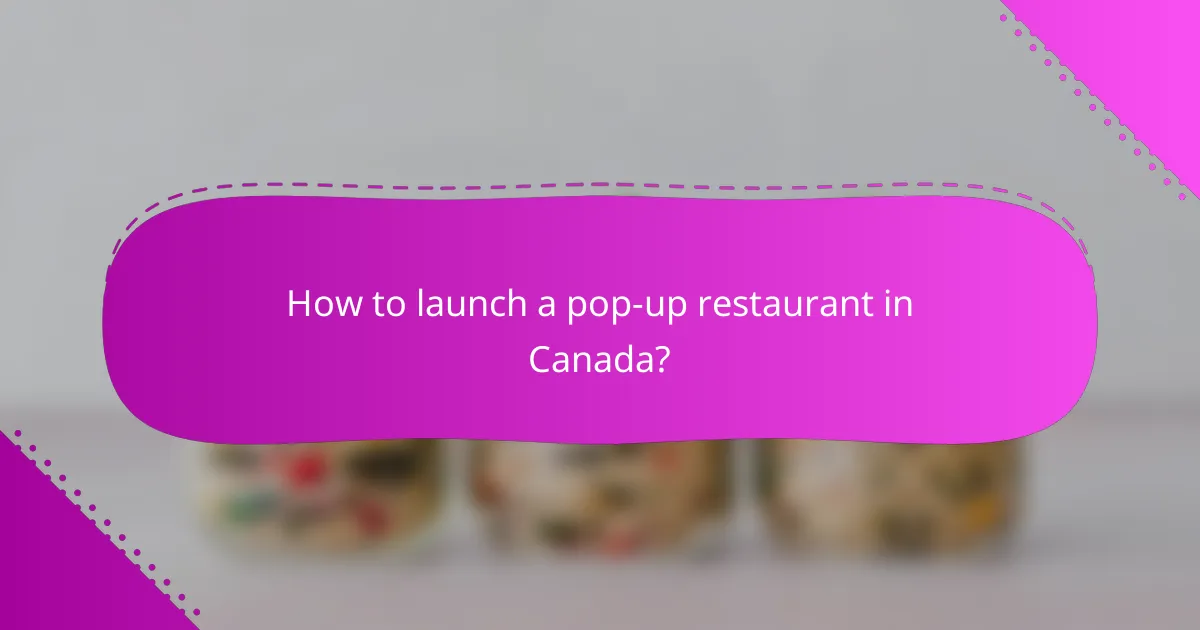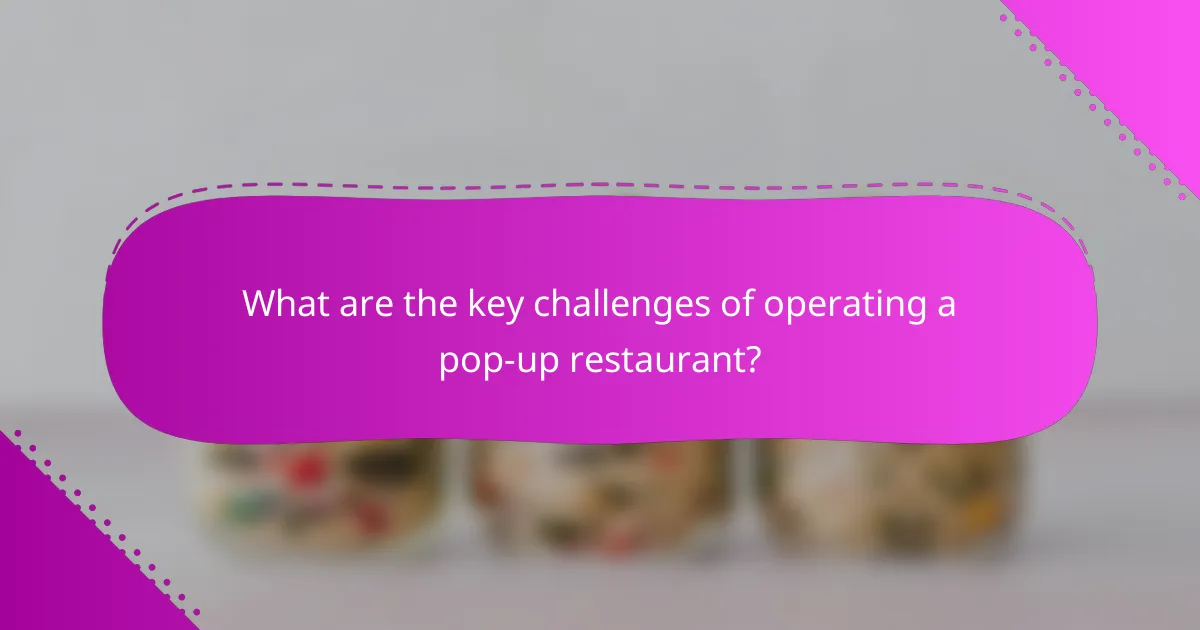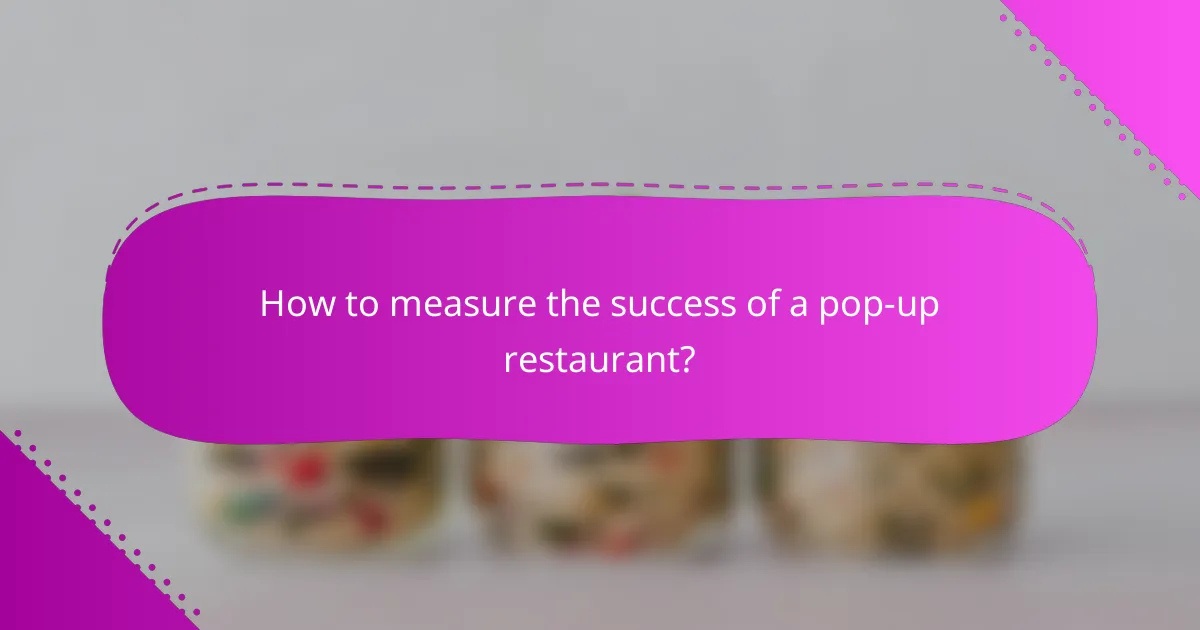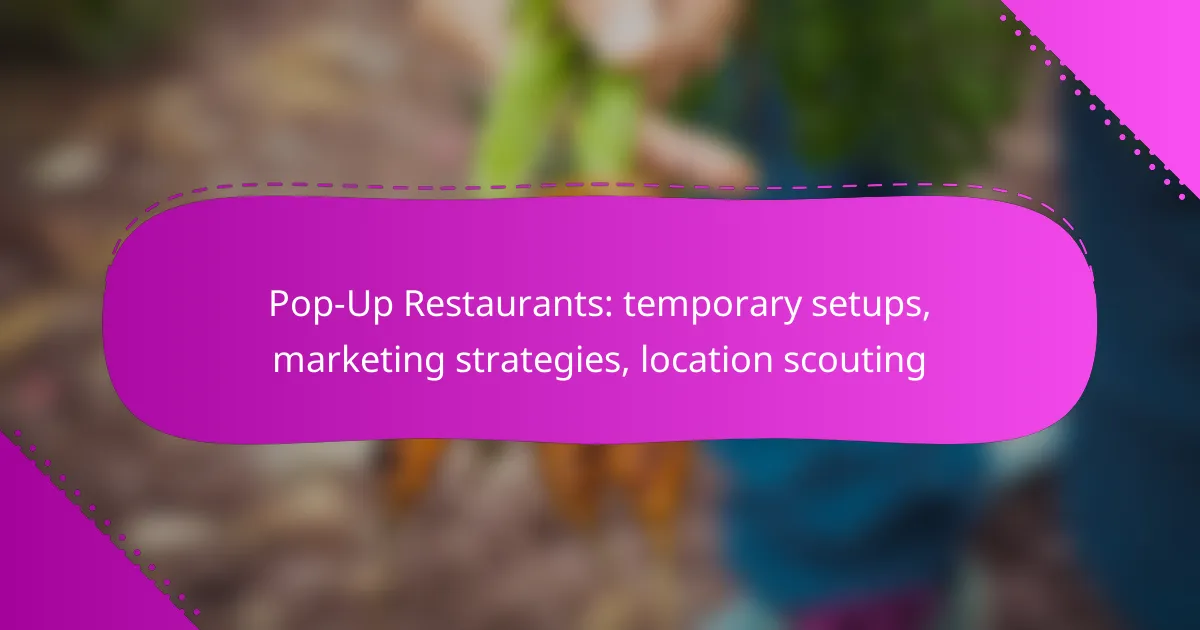Pop-up restaurants offer a unique opportunity for culinary entrepreneurs to test concepts and engage with customers in a temporary setting. Success hinges on meticulous planning, from crafting a standout concept and securing necessary permits to implementing effective marketing strategies that generate buzz. Location scouting is equally crucial, as selecting high-traffic areas can significantly impact visibility and profitability.

How to launch a pop-up restaurant in Canada?
Launching a pop-up restaurant in Canada involves careful planning and execution, focusing on a unique concept and effective marketing strategies. Key steps include identifying your target audience, securing permits, and selecting an appropriate location.
Identify target audience
Understanding your target audience is crucial for a successful pop-up restaurant. Consider demographics such as age, income level, and dining preferences to tailor your offerings effectively.
Conduct surveys or engage with potential customers on social media to gather insights. This information will help you create a menu and atmosphere that resonate with your audience.
Choose a unique concept
A unique concept sets your pop-up restaurant apart from competitors. Think about themes, cuisines, or experiences that are currently trending or underserved in your area.
For example, you might focus on a specific regional cuisine, a fusion of flavors, or a dining experience that combines food with entertainment. This distinctiveness can attract attention and generate buzz.
Secure necessary permits
Before launching, ensure you have all required permits and licenses. In Canada, this may include food handling permits, business licenses, and health inspections.
Check with local municipal regulations to understand the specific requirements in your province or city. Failing to secure the necessary permits can lead to fines or closure.
Select a suitable location
The location of your pop-up restaurant can significantly influence its success. Look for high foot traffic areas, such as busy streets, markets, or festivals, where your target audience frequents.
Consider temporary spaces like vacant storefronts or community centers that offer flexibility in terms of rental agreements. Evaluate the costs and logistics associated with each potential site.
Plan menu offerings
Your menu should reflect the unique concept while appealing to your target audience. Focus on a limited selection of dishes that can be prepared quickly and efficiently.
Incorporate seasonal ingredients to enhance freshness and reduce costs. Offering a few signature items can create a memorable experience and encourage repeat visits.

What marketing strategies work for pop-up restaurants?
Effective marketing strategies for pop-up restaurants focus on creating buzz and attracting customers quickly. Utilizing social media, collaborating with influencers, and engaging through events can significantly enhance visibility and drive foot traffic.
Leverage social media platforms
Social media platforms like Instagram, Facebook, and TikTok are essential for promoting pop-up restaurants. High-quality visuals of dishes and behind-the-scenes content can create excitement and anticipation among potential customers.
Consider posting regularly, using local hashtags, and engaging with followers to build a community. Posting countdowns to the opening day can also generate interest and encourage sharing among users.
Collaborate with local influencers
Partnering with local influencers can amplify your reach and credibility. Influencers with a strong following in the food niche can attract their audience to your pop-up, providing authentic endorsements.
Offer complimentary meals in exchange for social media coverage or host exclusive tasting events for influencers to create buzz. Ensure that the influencers align with your brand values for a more genuine connection.
Utilize email marketing campaigns
Email marketing remains a powerful tool for pop-up restaurants. Building an email list allows you to directly communicate with interested customers about your location, menu, and special events.
Send out regular newsletters with engaging content, such as sneak peeks of new dishes or limited-time offers. Keep your emails concise and visually appealing to maintain reader interest.
Create engaging events
Hosting engaging events can attract crowds and create memorable experiences. Consider themed nights, cooking demonstrations, or collaborations with local artists to draw in diverse audiences.
Promote these events through your social media and email campaigns to maximize attendance. Offering incentives like discounts or giveaways can further encourage participation and word-of-mouth marketing.

How to scout locations for pop-up restaurants in Canada?
Scouting locations for pop-up restaurants in Canada involves identifying areas with high foot traffic, analyzing local competition, and considering seasonal factors that may affect customer turnout. A strategic approach can enhance visibility and profitability for your temporary setup.
Analyze foot traffic patterns
Understanding foot traffic patterns is crucial for selecting a successful location for your pop-up restaurant. Look for areas with a consistent flow of pedestrians, such as busy streets, markets, or event venues. Tools like foot traffic analytics apps can provide insights into peak hours and average visitor counts.
Consider conducting on-site observations during different times of the day and week to gauge the volume of potential customers. Aim for locations where foot traffic is high, especially during lunch hours or weekends, as this can significantly impact your sales.
Evaluate local competition
Assessing local competition helps you identify gaps in the market and potential challenges. Visit nearby restaurants and food vendors to understand their offerings, pricing, and customer engagement strategies. This analysis can inform your menu and marketing approach.
Look for areas where competition is limited or where your concept can stand out. For instance, if most local eateries focus on fast food, a gourmet pop-up might attract a different clientele. Keep an eye on how competitors perform during peak seasons to gauge their impact on your business.
Consider seasonal factors
Seasonal factors can greatly influence the success of your pop-up restaurant. In Canada, weather conditions and holidays can affect customer turnout. For example, summer months may see increased foot traffic in outdoor markets, while winter might necessitate indoor locations.
Plan your pop-up around local events or festivals that align with your concept to maximize exposure. Additionally, consider offering seasonal menu items that resonate with customers during specific times of the year, such as warm beverages in winter or fresh salads in summer.

What are the key challenges of operating a pop-up restaurant?
Operating a pop-up restaurant presents several key challenges, including managing logistics, adapting to customer preferences, and ensuring compliance with health regulations. These factors can significantly impact the success and sustainability of the temporary dining experience.
Managing supply chain logistics
Effective supply chain logistics are crucial for pop-up restaurants due to their temporary nature. Operators must establish reliable relationships with suppliers to ensure timely delivery of fresh ingredients, often on short notice. It’s beneficial to identify local suppliers who can provide high-quality products while minimizing transportation costs.
Consider implementing a just-in-time inventory system to reduce waste and manage costs effectively. This approach allows for flexibility in menu offerings based on available ingredients, which can also enhance the dining experience by featuring seasonal dishes.
Adapting to changing customer preferences
Pop-up restaurants must be agile in responding to customer preferences, which can shift rapidly. Conducting market research and gathering feedback through social media or surveys can help identify trends and popular dishes. This information allows operators to adjust their menus and marketing strategies accordingly.
Additionally, offering limited-time specials or themed events can attract diverse clientele and create a sense of urgency. Engaging with customers directly can foster loyalty and encourage repeat visits, which is vital for short-term operations.
Ensuring compliance with health regulations
Compliance with health regulations is a critical challenge for pop-up restaurants, as they must adhere to local food safety standards. This includes obtaining necessary permits and licenses, which can vary significantly by location. Familiarizing yourself with local health codes is essential to avoid fines and ensure customer safety.
Regular training for staff on food handling and hygiene practices is necessary to maintain compliance. Consider conducting mock inspections to prepare for official health department visits, ensuring that all aspects of food preparation and service meet regulatory requirements.

How to measure the success of a pop-up restaurant?
Measuring the success of a pop-up restaurant involves evaluating various performance metrics, primarily focusing on sales, customer feedback, and overall brand exposure. These factors help determine whether the temporary setup met its goals and can inform future endeavors.
Track sales and revenue
Monitoring sales and revenue is crucial for assessing the financial performance of a pop-up restaurant. This includes daily sales figures, average transaction values, and total revenue generated during the operation period. Comparing these numbers against projected targets can provide insights into the restaurant’s profitability.
Consider tracking sales by menu item to identify popular dishes and adjust offerings accordingly. For example, if a specific dish accounts for a significant portion of sales, it may warrant a permanent spot in future menus. Aim for a clear understanding of both cash flow and profit margins to gauge financial health.
Utilizing point-of-sale systems can streamline this process, allowing for real-time data collection and analysis. Regularly reviewing sales data can help identify trends and inform marketing strategies for future pop-up events.
